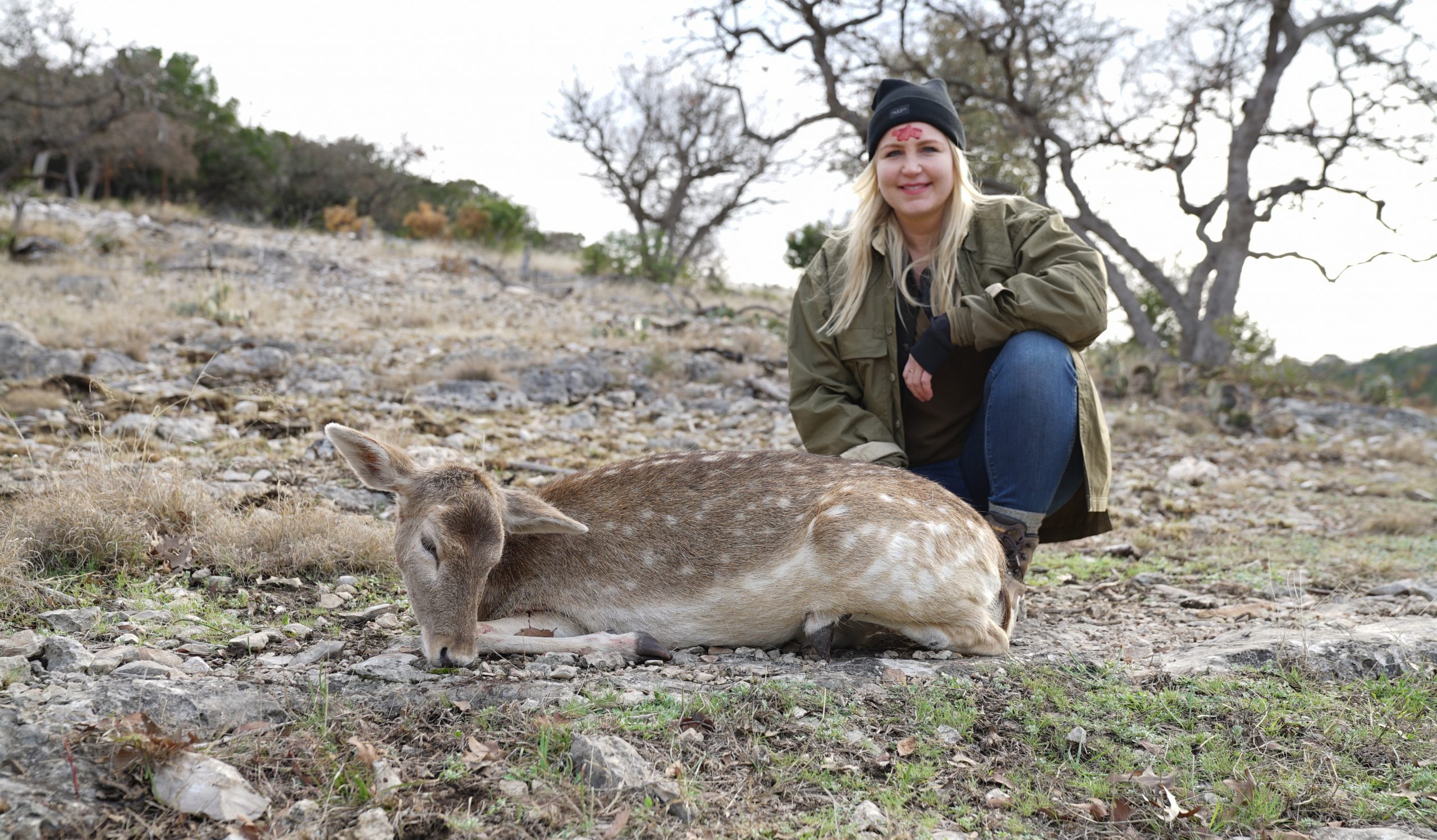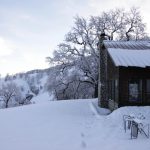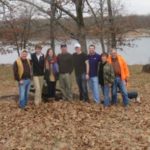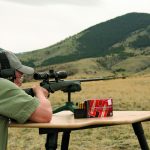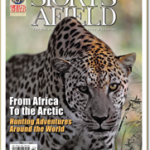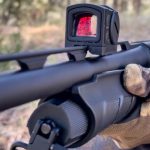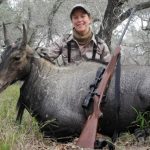The New Hunter Program at FTW Ranch turns novices into well-rounded, ethical, and skilled hunters.
If you want to become a hunter and you don’t have a hunting mentor, where do you start? Sure, a hunter education course is usually mandatory, but where does a novice go for information beyond the basics—how to aim and shoot properly, how to field-dress game, how to learn what to do with all that meat? There are a number of youth mentoring programs in various states, but few places for an adult hunter to get practical training.
A group of instructors and friends of the SAAM (Sportsman’s All-Weather, All-Terrain Marksmanship) course at FTW Ranch in Texas got to talking about this problem one evening around the campfire. An idea formed, and the New Hunter Program at SAAM was born.
SAAM, which specializes in training hunters to improve and refine their shooting skills, used its existing resources to team devise an inspired curriculum. Tim Fallon, owner of FTW and SAAM, said, “The team put into the course all of the elements that we feel a new hunter needs at the beginning, but also will fill in the blanks for hunters with some experience but not a lot of knowledge. The goal is that everyone leaves the course a better hunter.”
Upon arrival at the ranch, students are fitted for their guns. In this case, all students were provided with a Remington 700 in 6.5 Creedmoor, topped with a Swarovski scope, and Hornady ammo—all included in the price of the course. Some students chose classic hunting-style rifles and others opted for the platform range rifle with pistol grip.
The course starts with the foundation of shooting proficiency and firearm safety. Students spend a morning in the classroom with Doug Prichard and Dave Knesek, both former Navy SEALs who teach regularly at the ranch. Students learn about parts of the rifle and scope, MOA and mil-dots. A discussion of shot placement and hunter ethics follows, and then before lunch on the first day, students are hands-on in the work room, cleaning and getting familiar with their firearms.

Shooting sessions on the range familiarize everyone with their guns and whet their appetites for what was next. Each student in the five-day class gets to take part in a cull hunt for blackbuck and fallow deer does. At the course I attended recently, two students were assigned to each FTW guide, and the hunting began on the second day at 5:30 a.m.
The ever-changing Texas weather was windy and cold for the first early morning hunt. The rugged canyons and cliffs of FTW provide challenging conditions for even a skilled hunter. Some of the students were successful on the first morning, but many returned empty-handed but with significantly better understanding of the process. Morning and afternoon hunts continued during the week for all students, until each one was able to bring an animal to the skinning shed and get busy.
In addition to the daily routine of range time and hunting, students heard experts gave talks on various topics. Dr. Tim Doucet discussed what deer can see versus what humans can see, helping put spotting and stalking game animals and the importance of camouflage into context. Game Warden Clint Graham discussed the role of law enforcement in protecting natural resources. Understanding how to properly use and conserve natural resources is a large part of hunting ethics. Graham also talked about the role of land managers and landowners in the equation.
On most guided hunts, once an animal is taken, the gutting, cleaning and quartering of the animal is left to a team hired by the outfitter, and the hunter is free to celebrate, perhaps standing by and watching as the experts work. Not in this course. Each student was front and center in the skinning shed, knife in hand, learning what to do.
Wildlife biologist and TV personality Larry Weishuhn performed a necropsy on the first animal brought in–a female blackbuck. As he gutted the animal, he not only explained the process but also discussed the various parts of the anatomy, showing the students the exact location of the vitals and examining the stomach contents to help the students learn what the animal had been eating.
Larry was also on hand in the skinning shed with each student to show the proper way to begin skinning. As we observed the first students intently removing the skin from their animals with sharp knives, Weishuhn said to me, “This course is really remarkable in that it takes any hunter, especially a novice, and makes them a more complete hunter. The knowledge gained here will apply later to almost any type of hunt someone can undertake.”
Another instructor, Gary Broach of Rhodes Taxidermy, showed students how to prepare a skin for mounting, and also demonstrated how to quarter and butcher the animal. The results were steaks, chops, hams, and trim to be made into ground meat.
Capping off the full field-to-table experience was time in the kitchen with Chef Joshua Schwencke of Gastronomy Life Events, who showed the students how to prepare game meat for cooking and made suggestions on how to cook various parts of the kill. At the request of one student, Chef Josh prepared a blackbuck heart ceviche, which many in the group sampled. Each student also got a hands-on lesson in sausage making, using the gourmet recipes of Chef Josh—Thai-inspired or German-style. Everyone was sent home with at least a pound of sausage made from game meat mixed with pork fat and other flavorings. Dinner on the last day was a chef-prepared feast of wild game— followed by a beer tasting of local Texas brews.
One hallmark of SAAM courses in general is the team’s ability to quickly create a tight-knit culture from the diverse experience of students, instructors, presenters, and guides. Whether one is shooting for the first time, or has been at it for twenty-plus years, the camaraderie that quickly forms ensures that no one is left behind.
The experienced instructors size students up quickly to help them form good new habits and break bad ones. Dave Knesek is one of the expert instructors at SAAM. He said, “I know how to take a look at someone shooting a few shots and immediately see which are the most significant things to correct. Once someone can fix those major things, the rest is easy.”
Instructor Doug Prichard loves watching people learn. “Students are hungry for knowledge. We provide it and they just soak it up. That for me is the best part of this course.” Doug also addressed the maxim “failure is not an option” by turning it around. “In fact, we learn from failure. It motivates us to do better and to figure out how to do it right.” The expert instructors correct your mistakes with an eye to improving your shooting and by extension, your hunting proficiency.
The hunting guides follow what students are learning in class and provide their own instruction in the field as students engage in spotting, stalking, discussing distances and windage, as well as observing animal behavior. By the end of the course, all students had bagged an animal to round out their experience.
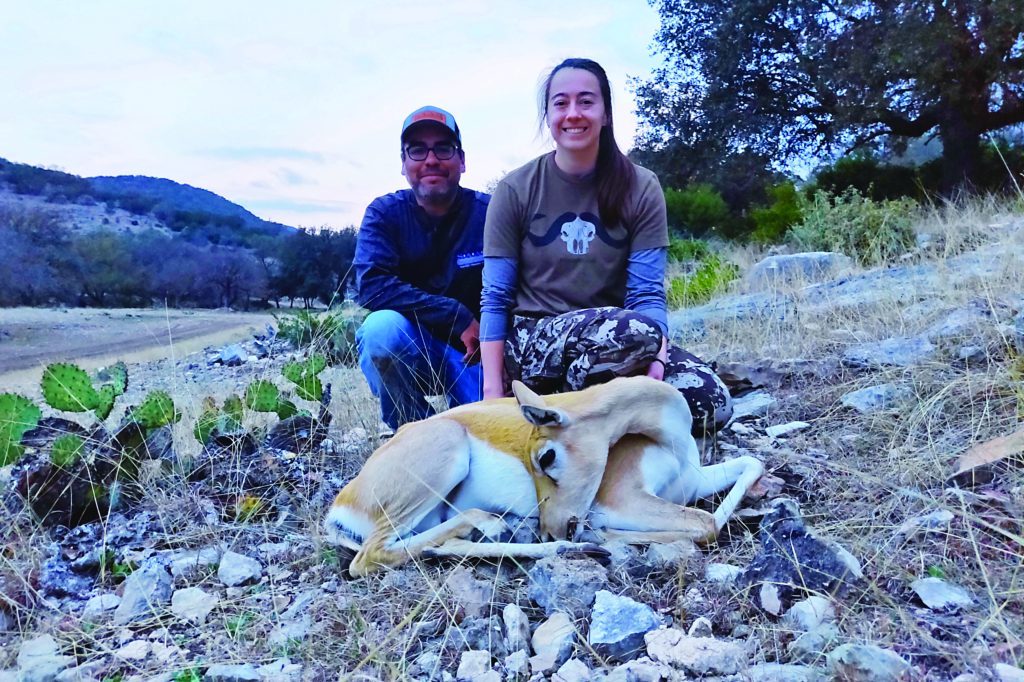
Caroline Thompson, of Dallas, Texas, told me she was not sure about attending the course. Although interested in hunting, she was completely inexperienced. She wondered if she would feel safe, and if she would be able to keep up with others who were bound to have more experience than her. She wasn’t even sure what to wear. The staff worked with her before arrival to answer her questions, and Caroline ended up enjoying the experience. She said, “If you want to start hunting, this is definitely the place to go.” Caroline bagged a lovely fallow doe, which she skinned herself.
Karrie Meadows, of Plano, Texas, a novice with some experience, liked the way things were explained in an accessible and methodical way. “No matter what your background or previous skill level, this is a course for anyone who wants to learn about hunting. With a wide variety of lessons and topics, everyone leaves with a new appreciation or perspective.” Meadows had her sights on a female blackbuck, first at 300 yards, but then consulted with her guide Efren Hernandez about the wind and the shot placement, precisely as the SAAM training encourages. They decided to move to a better position at the bottom of the canyon, and Karrie made a successful 145-yard shot.
In the evening of the second day, I was watching a group of blackbuck females at 285 yards with my guide. Thanks to the earlier instruction and practice on the range, one shot to the lungs brought down the antelope. Having seen the necropsy earlier in the day helped me visualize precisely where to place the shot.
It was in the skinning shed where I could really feel my inexperience. As I wielded the knife, removing the skin from the blackbuck, I frequently asked, “Am I doing this right?” My tutor and classmates reassured me patiently every time. At the end of the process, I had quarters of meat ready for butchering and a hide ready for tanning.

Another student, Shaman Bakshi, of southern California, also a novice hunter, sought out this course because even though he has plenty of access to urban firing ranges, he found nothing to compare with the expert instruction or the facilities of FTW Ranch and the SAAM New Hunter Program. He said, “This is the only place with accurate training that I could find—perhaps due to COVID, or because good training may not exist in a consistent way. If it does, I am not aware of it.” Bakshi plans to return to SAAM later this year for the Safari course, which provides African safari simulations combined with shot placement on moving and charging targets, more wind-calling scenarios, and training in using rifle scopes effectively.
The New Hunter Program is rare in the world of shooting and hunting. The SAAM faculty have done a brilliant job of bringing together a winning combination of location and game, classes and sessions, and personable and skilled instructors. The result is a unique and intense experience that delivers on its goal to turn novices into more complete hunters. Those who have gone through this comprehensive experience, building solid skills from a solid base, are likely to go back into the field and hunt, again and again.
Learn about the New Hunter Program by visiting ftwsaam.com and clicking on the SAAM tab.

